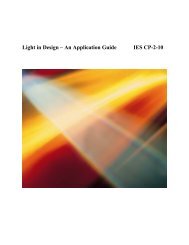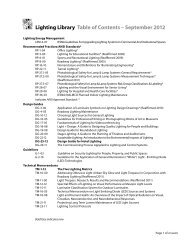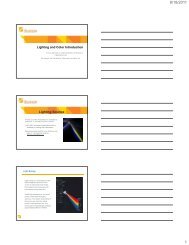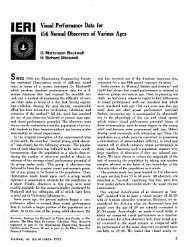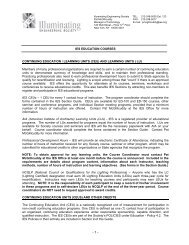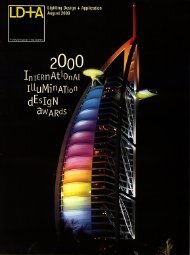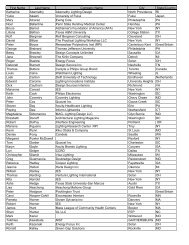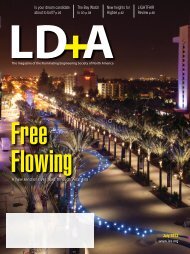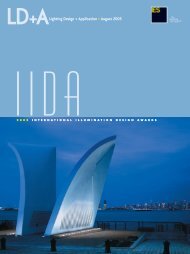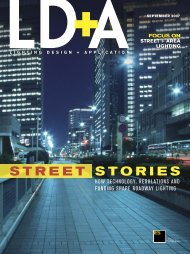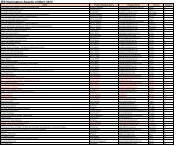faces of the future - Illuminating Engineering Society
faces of the future - Illuminating Engineering Society
faces of the future - Illuminating Engineering Society
Create successful ePaper yourself
Turn your PDF publications into a flip-book with our unique Google optimized e-Paper software.
LED WATCH<br />
Retrot<br />
your lighting<br />
advantage<br />
RETROFIT CASE STUDY #416<br />
World Trade Center<br />
Boston<br />
Retro t Site Lighting<br />
Boston. MA<br />
Existing :250w HPS/Surface<br />
Retro t: 85w Induction 5K<br />
Watts saved : 8,250 watts/hr<br />
Fixture: SPC1220DU855KG2<br />
Saving energy is <strong>the</strong> goal,<br />
providing excellent lighting is<br />
<strong>the</strong> prize.<br />
Contact your Spectrum<br />
Lighting Representative for all<br />
your lighting needs.<br />
REMODELIGHT SERIES<br />
LIGHTING INC.<br />
www.speclight.com<br />
will potentially make a significant<br />
impact on <strong>the</strong> industry when it’s<br />
published, is IES TM-21. Intended<br />
for use with LM-80 test data, it is<br />
expected to specify a method for<br />
estimating <strong>future</strong> lumen depreciation<br />
<strong>of</strong> LED packages and modules,<br />
which can <strong>the</strong>n be used in determining<br />
<strong>the</strong> expected useful life <strong>of</strong> an<br />
LED product. This potential useful<br />
life <strong>of</strong> an LED package or module is<br />
only one aspect <strong>of</strong> total LED luminaire<br />
reliability—but it is a key one,<br />
and an especially tricky one as well.<br />
Color is an important issue for<br />
solid-state lighting, and in <strong>the</strong><br />
September issue <strong>of</strong> LD+A, I wrote<br />
about <strong>the</strong> Color Quality Scale, a<br />
new metric developed by NIST to<br />
convey <strong>the</strong> color quality <strong>of</strong> lighting<br />
products more accurately than <strong>the</strong><br />
widely used Color Rendering Index.<br />
In April <strong>of</strong> this year, NEMA published<br />
SSL-3, a standard that will<br />
have an impact on LED color quality.<br />
Entitled “High-Power White LED<br />
Binning for General Illumination,”<br />
it provides a way for chip manufacturers<br />
to bin <strong>the</strong>ir chips based<br />
on color, which will translate into<br />
more consistent color quality <strong>of</strong><br />
LED lighting products.<br />
A couple <strong>of</strong> white papers that were<br />
published by NEMA a while back may<br />
also eventually result in standards,<br />
because <strong>the</strong> subjects <strong>the</strong>y cover are<br />
very much on people’s minds. LSD-<br />
44 “Solid-State Lighting—The Need<br />
for a New Generation <strong>of</strong> Sockets<br />
and Interconnects,” and LSD-45<br />
“Recommendations for Solid-State<br />
Lighting Sub-Assembly Inter<strong>faces</strong><br />
for Luminaires,” both deal with <strong>the</strong><br />
key issue <strong>of</strong> replaceability. That is,<br />
<strong>the</strong>y deal with <strong>the</strong> importance <strong>of</strong> creating<br />
a standard format for replacing<br />
individual LED arrays within a<br />
luminaire, which would go a long<br />
way toward making <strong>the</strong>m modular,<br />
<strong>the</strong>reby creating a great deal more<br />
flexibility for manufacturers and<br />
specifiers, alike.<br />
These are some <strong>of</strong> <strong>the</strong> key solidstate<br />
lighting standards that are in<br />
<strong>the</strong> works, but it’s by no means<br />
an exhaustive list. Developing SSL<br />
standards is an ongoing process,<br />
because <strong>the</strong> technology is still evolving.<br />
Although it’s unglamorous<br />
work, <strong>the</strong> pay<strong>of</strong>f is big: less guesswork<br />
about products, in terms <strong>of</strong><br />
<strong>the</strong>ir performance and characteristics.<br />
And that, in turn, will raise <strong>the</strong><br />
confidence level when specifying<br />
those products.<br />
James Brodrick is <strong>the</strong><br />
lighting program manager<br />
for <strong>the</strong> U.S. Department<br />
<strong>of</strong> Energy, Building Technologies<br />
Program. The Department’s national<br />
strategy to guide high-efficiency,<br />
high-performance solid-state lighting<br />
products from laboratory to market<br />
draws on key partnerships with <strong>the</strong><br />
lighting industry, research community,<br />
standards organizations, energy-efficiency<br />
programs, utilities and<br />
many o<strong>the</strong>r voices for efficiency.<br />
BACK ISSUES<br />
ARE NOW ONLINE<br />
WWW.IESNA.ORG<br />
+e-mail a letter to<br />
<strong>the</strong> editor:<br />
ptarricone@ies.org<br />
24 www.ies.org



